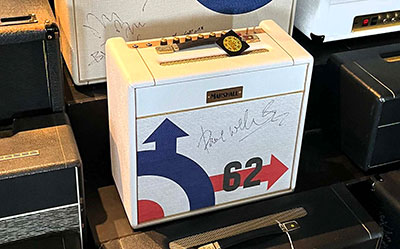The Marshall factory in Bletchley recently received a visit from a team of researchers from the University of Huddersfield’s Amplification Project, who were keen to witness every stage in the manufacture Marshall’s iconic guitar amplifiers.
Formed in 1962 by Jim Marshall in Hanwell, West London, Marshall’s famous black amps have been used by the likes of Jimi Hendrix, Jeff Beck, Slash, Ritchie Blackmore and Paul Weller. Marshall even created a special limited-edition amplifier that ‘goes up to 11’, with panel legending acknowledging their mention in the classic ‘rockumentary’, This is Spinal Tap.
 Led by Professor Steve Waksman – one of the world’s leading scholars in the study of music technology, instruments and live music – the Amplification Project is exploring the evolution of amplified sound over the course of five years, backed by £5m from the Leverhulme Trust.
Led by Professor Steve Waksman – one of the world’s leading scholars in the study of music technology, instruments and live music – the Amplification Project is exploring the evolution of amplified sound over the course of five years, backed by £5m from the Leverhulme Trust.
Six post-doctoral researchers and 12 PhD students are undertaking the most extensive study of the subject to date under the guidance of a team headed by Waksman, who previously taught at the prestigious Smith College in Massachusetts.
Outputs planned for the project include at least four books, as well as journal articles from the research team, as well as conferences and events in Huddersfield. ‘After reading everything I could get my hands on about the company, Marshall’s museum provided a unique opportunity to see many of the most pivotal Marshall amps up close,’ Waksman says.
‘There are amps that were played by Slash, Lemmy from Motörhead, Zakk Wylde, Paul Weller, and the infamous Spinal Tap amp, as well as models of the amps that have been played by Jimi Hendrix, Pete Townshend, Ritchie Blackmore and a host of other rock legends.
‘In the middle of it all was the very first amp built by Marshall, which is now behind a glass display case, enshrining the moment when Jim Marshall and his collaborators became the manufacturer of amps that would be the first choice for multiple generations of performing artists, he continues. ‘As eyeopening as the museum was, the real excitement came with the factory tour…
‘We spent over an hour walking through the working Marshall factory in the middle of a normal workday for the company’s employees. We saw circuit boards being soldered together by a dedicated machine, while in a nearby workstation a different set of circuit boards were being hand-wired by highly skilled craftspeople. In other rooms of the factory, we saw cabinets being carved and assembled, being covered in Tolex , and saw the chassis with all the requisite components being put together and installed.
‘We also got glimpses into the distinctive corporate culture of Marshall– signs that encouraged workers to “make it loud” and warned Danger: Guitar will not work properly without Marshall.’
The research project aims to explore the history of amplification, its emergence, economic structures, and its impact on musical instruments and public and private spaces. It is one of the largest research projects ever carried out in the field of popular music studies, and emphasises the importance of popular music studies and the role of amplification in enhancing musical experiences and community connections. The project will be interdisciplinary, involving history, ethnography, music theory and architectural acoustics.
‘As our project evolves, I hope that we can use this knowledge as a building block to gain greater levels of insight into how amps are made and designed and what features contribute to the distinctive tonal properties that they possess,’ Waksman says.
More: https://pure.hud.ac.uk

